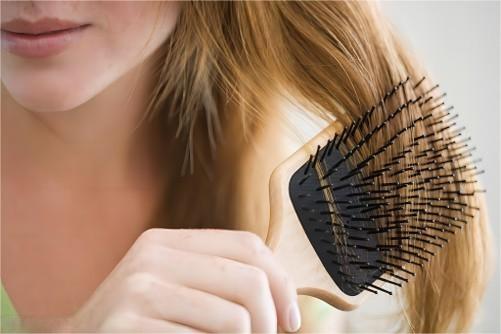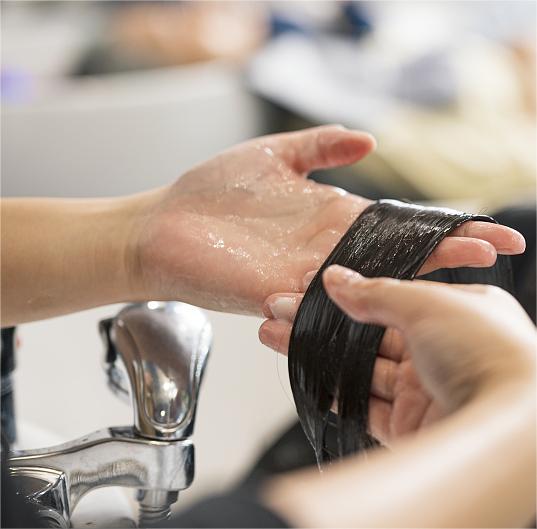We're diving deep into a topic that's all too relatable for many of us: the ever-elusive secret of knowing if your hair is thinning. Don't worry, though – this blog post has got your back.
Common Causes of Hair Thinning:
Hair thinning can be triggered by a variety of factors. Some of the most common causes include genetics, hormonal fluctuations, and lifestyle choices. Genetics plays a significant role in hair thinning, as family history can predispose you to conditions like male or female pattern baldness. Hormonal changes, such as those that occur during pregnancy or menopause, can also lead to hair thinning. Additionally, lifestyle choices, like a poor diet, smoking, and excessive alcohol consumption, can impact the health of your hair, making it essential to consider these factors when assessing your own hair.
Age and Hair Thinning:
Age is a natural factor that can influence the thickness of your hair. As we grow older, the hair growth cycle may slow down, and hair follicles might become less active. This can result in thinner, finer hair over time. Understanding the age-related changes in your hair can help manage your expectations and guide you on how to maintain healthy hair as you age.

Home Remedies for Detecting Thinning Hair:
Not everyone can visit a professional for hair analysis, but there are simple home remedies and tricks to assess hair thickness.
1. The "Ponytail Test": This is a straightforward test that anyone can perform at home. Here's how it works:
Start by gathering your hair into a loose ponytail at the back of your head.
Take note of the circumference of the ponytail.
Over the course of a few weeks, periodically measure the circumference in the same way.
If you notice a gradual decrease in the thickness of your ponytail, it could be an early sign of hair thinning.

2. Handheld Mirror Scalp Check: To check your scalp for signs of thinning, follow these steps:
Use a handheld mirror and stand in front of a larger mirror.
Part your hair to expose your scalp, or ask a friend or family member for help.
Examine your scalp carefully for any widening parts or visible scalp areas where hair is used to cover.
Look for signs of miniaturized or fine hair, as these may indicate hair loss.
Take pictures if necessary to track changes over time.

3. Wash and Comb Method: This method can be helpful for assessing hair loss during your regular hair care routine: Wash your hair as you normally would.
Comb your hair gently with a wide-toothed comb after it's towel-dried.
Check the comb for any excessive hair loss. It's normal to lose a few strands, but if you notice a significant amount of hair on the comb, it could be an indication of thinning.

4. Natural Light Test: This method helps in spotting thinning by using natural light to your advantage: Stand by a well-lit window or go outside during daylight. Examine your hair and scalp in natural light, which can reveal thinning areas that might not be as noticeable in artificial lighting.
Advanced Techniques for Hair Analysis:
For those who want a more thorough assessment of their hair, advanced techniques can provide detailed insights.
-
Hair Strand Analysis Under a Microscope:
- This method involves examining individual hair strands under a microscope to assess their condition.
- Benefits: It allows for a close-up look at the health of each hair strand, revealing issues like hair shaft abnormalities, thinning, or damage.
- Limitations: While informative, it may not identify the root causes of hair thinning, such as hormonal imbalances or underlying health issues.
-
Hair Pull Test:
- The hair pull test is performed by a professional, usually a dermatologist or trichologist.
- Benefits: It can determine the percentage of hair in the resting phase (telogen) and actively growing phase (anagen). A higher percentage of telogen can indicate a hair loss problem.
- Limitations: It doesn't provide information about the specific cause of hair thinning, so additional tests may be required.
-
Trichologist's Evaluation:
- A trichologist is a specialized hair and scalp expert who can conduct a comprehensive assessment.
- Benefits: Trichologists can provide a thorough evaluation, consider multiple factors, and diagnose the root causes of hair thinning. They may recommend personalized treatment plans.
- Limitations: The services of a trichologist may not be readily available in all areas, and it can be more costly than other assessments.
Hair Thinning in Men vs. Women:
Hair thinning can manifest differently in men and women due to hormonal variations.
-
Male Pattern Hair Thinning:
- In men, the most common type of hair thinning is referred to as male pattern baldness or androgenetic alopecia.
- Manifestation: Male pattern baldness often begins with a receding hairline at the temples, followed by thinning at the crown. Eventually, the two areas may merge, leaving hair only around the sides and back of the head.
- Hormonal Influence: It is primarily driven by the hormone dihydrotestosterone (DHT), which causes hair follicles to shrink over time.

-
Female Pattern Hair Thinning:
- Female pattern hair thinning, also known as androgenetic alopecia, is the female counterpart to male pattern baldness.
- Manifestation: In women, hair thinning tends to be more diffuse. It often involves widening parts and a general decrease in hair volume rather than the formation of bald spots.
- Hormonal Influence: While DHT plays a role, hormonal changes, particularly during menopause, can also contribute to female pattern hair thinning.

-
Telogen Effluvium in Both Genders:
- Telogen effluvium is a type of hair shedding that can affect both men and women.
- Manifestation: It is characterized by sudden, widespread hair loss, often triggered by factors like extreme stress, illness, or certain medications.
- Hormonal Influence: While hormonal changes are a factor in some cases, it is often a response to a specific triggering event.
-
Health Conditions and Hair Loss:
- Certain health conditions, like polycystic ovary syndrome (PCOS) in women or prostate issues in men, can lead to hormonal imbalances and subsequent hair thinning.
- Manifestation: The way hair thinning appears can vary depending on the underlying health issue.
- Hormonal Influence: These conditions can disrupt hormonal balance, which can contribute to hair loss.
Preventive Measures for Hair Thinning:
Prevention is often the best approach when it comes to hair thinning.
-
Nutrient-Rich Diet:
- A diet rich in essential nutrients, such as biotin, iron, and protein, is vital for maintaining healthy hair. Include foods like eggs, lean meats, leafy greens, and nuts in your diet to support hair growth and strength.
-
Hydration:
- Staying well-hydrated is crucial for overall hair health. Dehydration can lead to brittle and dry hair, which is more prone to breakage.
-
Scalp Care:
- A clean and healthy scalp is the foundation for strong hair. Regularly cleanse your scalp to remove excess oil and product buildup.
-
Gentle Hair Care:
- Avoid harsh hair care practices, such as excessive heat styling, tight hairstyles, and aggressive brushing. Treat your hair gently to minimize damage.
-
Stress Management:
- Chronic stress can lead to hair loss. Practice stress-reduction techniques like meditation, yoga, or deep breathing exercises to manage stress effectively.
-
Regular Exercise:
- Physical activity promotes better blood circulation, which, in turn, nourishes hair follicles. Aim for regular exercise to maintain a healthy scalp.
-
Avoid Smoking and Excessive Alcohol:
- Smoking and excessive alcohol consumption can hinder proper circulation, affecting hair health. Quitting smoking and moderating alcohol intake can be beneficial for your hair.
-
Early Intervention:
- Pay attention to your hair's changes and act early if you notice signs of thinning. Early intervention can prevent further hair loss and improve your chances of regrowth.
-
Avoid Extreme Diets:
- Crash diets and extreme weight loss regimens can deprive your body of essential nutrients, leading to hair loss. Opt for gradual, balanced weight management.
-
Use Hair-Friendly Products:
- Choose hair care products that are free from harsh chemicals and sulfates. Look for products designed to promote hair health and thickness.
Treatment Options for Hair Thinning:
Explore the wide range of treatment options available for hair thinning.
Certainly, let's provide more specific details about treatment options for hair thinning, including both non-drug and drug approaches:
-
Non-Drug Approaches:
- Invisible Clip-Ins: Invisible clip-in hair extensions can instantly add volume and thickness to your hair. They are easy to use and a non-invasive option to enhance your hair's appearance. Clip-ins come in various lengths and colors to suit your style.
- Low-Level Laser Therapy (LLLT): LLLT devices, such as laser combs or helmets, use low-level laser light to stimulate hair follicles and promote hair growth. They are non-invasive and have minimal side effects. Consistency in use is essential for effectiveness.
- Scalp Massage and Essential Oils: Regular scalp massages using essential oils like rosemary, lavender, or peppermint can improve blood circulation to the scalp and strengthen hair. This natural approach is low-risk and can be soothing.
-
Over-the-Counter Products:
- Minoxidil (Rogaine): Minoxidil is a topical medication available without a prescription. It's applied directly to the scalp and is known to promote hair regrowth. The effectiveness varies from person to person, and it may take several months to see results.
-
Prescription Medications:
- Finasteride (Propecia): Finasteride is an oral medication prescribed for men. It works by reducing the effects of the hormone DHT, which contributes to male pattern baldness. It can slow hair loss and, in some cases, promote regrowth. Potential side effects include sexual dysfunction, and it is not approved for use in women.
-
Surgical Interventions:
- Hair Transplants: Hair transplants involve the surgical removal of hair follicles from one part of the body (usually the back or sides of the scalp) and their transplantation to areas with thinning or no hair. It is an effective but more invasive option. Potential side effects include scarring and post-operative discomfort.
- Scalp Micropigmentation (SMP): SMP is a non-invasive procedure that uses micro-tattooing to create the appearance of hair follicles on the scalp. It's suitable for those with extensive hair loss or those who prefer a closely cropped style. The results are immediate, and the procedure is generally safe.
- Platelet-Rich Plasma (PRP) Therapy: PRP therapy involves drawing a small amount of your blood, processing it to concentrate the platelets, and then injecting the PRP into your scalp. It can stimulate hair follicles and promote hair growth. Side effects are typically minimal.
- Laser Hair Therapy (LHT): LHT is a non-invasive treatment that uses red light lasers to stimulate hair follicles. It can improve hair density and overall hair health with no known side effects.
When discussing treatment options for hair thinning, it's important to consider the individual's specific needs and preferences, potential side effects, and the time required to see results. A consultation with a healthcare professional or dermatologist can help determine the most suitable treatment approach for each person.





